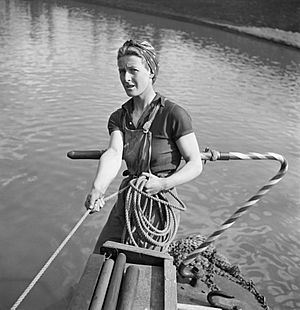Boatwomen's training scheme facts for kids
The boatwomen's training scheme was a special program in the United Kingdom during World War II (the Second World War). It was created to encourage women to work on Britain's busy canal network. The Grand Union Canal Carrying Company (GUCCC) started the scheme in 1942. Later, in 1944, the Ministry of War Transport took it over. The program ended in 1945 after the war finished.
These women were often called the Idle Women. This was because of the special badge they wore instead of a uniform, which had "IW" for Inland Waterways. Around 100 women joined the scheme, but only about 45 finished the training. Only six women are known to have worked as boatwomen for the entire time the scheme was running.
Contents
Why Women Were Needed on Canals
At the start of World War II, Britain's canals faced a big problem: not enough workers. Many men who used to work on the canals joined the military. Also, other jobs offered better pay, drawing more workers away.
In 1941, there was a push to get more men to work on the waterways. However, the Grand Union Canal Carrying Company (GUCCC) also received 47 applications from women. At first, they said no. They believed only women from boating families could do the job.
But things changed. In late 1941, the Ministry of War Transport contacted two boaters, Daphne March and Frances Traill. They had been transporting goods on March's own boat, Heather Bell, since 1940. The Ministry asked if they would help the GUCCC train other women to work the boats. March and Traill agreed and brought in Eily "Kit" Gayford to help.
How the Training Worked
Newspaper adverts for the scheme appeared in early 1942. The first trainees began their work in May 1942. Most of the women who applied were from middle-class backgrounds.
The training involved two trainees working with either Daphne March, Frances Traill, or Kit Gayford. They would be in charge of two canal boats:
- A 'motor' narrowboat (which had an engine).
- An unpowered 'butty boat' (which was towed by the motor boat).
The trainees usually made two trips. These trips were often between London and Birmingham or Oxford. They carried important goods like grain, coal, or metal.
The first trip was a test. It helped the trainees see if they could handle the tough conditions and the way of life on the canals. If they decided to continue, the second trip gave them more detailed training. After about six weeks, the women were considered skilled enough to work their own boats.
Their training taught them many things, including:
- How to steer and control the boats.
- How to operate locks, which help boats move between different water levels.
- How to load and unload heavy cargo.
- The geography of the canals, so they knew their routes.
Pay and Working Conditions
During their training, each woman was paid £2 per week. Once they qualified, their pay went up to at least £3 per week. The exact amount depended on how much cargo their boat carried. This money was then split among the three women in the crew.
The women did not receive a uniform. The GUCCC gave them a list of clothes they would need, but the women had to buy these themselves. The only special item they had was a National Service badge with "IW" on it, which stood for Inland Waterways. This "IW" badge led to other boatmen calling them Idle Women. However, the nickname stuck, and the women proudly used it themselves.
Once qualified, the women were allowed 3 to 6 days of unpaid leave after every second trip. They did not get any extra food rations, unlike other national service groups like the Women's Land Army. However, special arrangements were made so they could use their ration books at any shop, rather than being tied to shops in one place.
The work was very hard and tiring for most of the women. They often worked seven days a week, sometimes for 18 to 20 hours a day.
The Scheme Under Government Control
The Ministry of War Transport (MWT) took over running the scheme in 1944. Part of the MWT's plan was to expand the scheme to other canals across Britain.
For a short time, one crew of three women worked on the Gloucester and Sharpness Canal. They used a boat pulled by a horse. The MWT also managed to get Canal Transport Limited, a major company on the Leeds and Liverpool Canal, to use women crews. However, only eight women had been trained there, with four more in training, before the war in Europe ended. This meant the scheme was no longer as important.
The End of the Scheme
Work on the Grand Union canal continued even after VJ Day (the day Japan surrendered). But soon after, the women found there was no more work for them. They became unemployed and were free to leave. It is thought that at its busiest, about 45 women were working on the Grand Union canal. They crewed between 15 and 30 boats.
Remembering the Boatwomen
The hard work of these women is remembered today.
- A special plaque was put up to honor the women at the Canal Museum in Stoke Bruerne, Northamptonshire, in 2008.
- Three stage plays have been created based on the experiences of the boatwomen:
- Mikron Theatre performed Imogen's War in 1992.
- Alarum Theatre produced Isobel's War and Idle Women and Judies in 2016.
- Several women who trained in the scheme also wrote books about their time as boatwomen.
Famous Trainees
- Olga Kevelos
- Sonia Rolt


